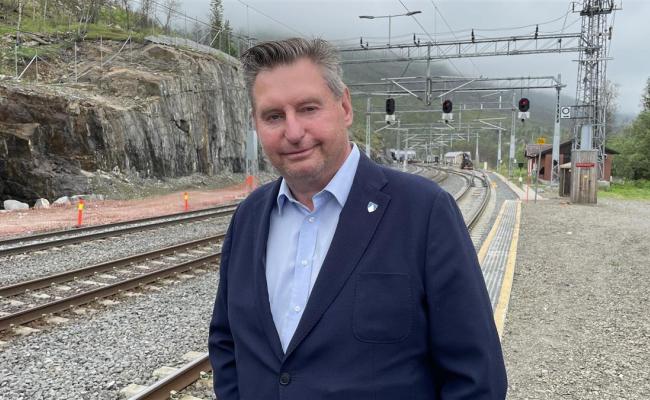Over 200 000 Tonnes of Seafood Sent Annually via the Ofoten Line: The Derailment Highlights Need for Double Track

Trond Davidsen is Deputy Managing Director of the Norwegian Seafood Federation, the national association for the fisheries and aquaculture industry. (Photo: Siv Dolmen / the Norwegian Seafood Federation).
Significant amounts of seafood are annually transported via railway from Narvik in Northern Norway through Sweden to Oslo. After the Iron Ore Line derailment, trailers have transported the goods to Kiruna. However, if the situation persists and the winter fisheries get in full swing, there might be a lack of available vehicles, says the Deputy Managing Director of the Norwegian Seafood Federation.
Over 200,000 tonnes of seafood from Northern Norway is sent annually via railway from Narvik to Oslo through Sweden, and the derailment on the Iron Ore Line in Northern Sweden is also consequential for this transport.
The derailment on the railway line, called the Ofoten Line on the Norwegian side, has put a stop to train traffic on the line between Narvik and Kiruna. The incident led to significant damage to the rails, sleepers [substrate for railway tracks, ed. note], switches, and overhead lines over a 15-kilometer stretch, and traffic is not expected to resume until the end of January.
The seafood that originally was to be transported by train from Narvik is now sent by trailers to Kiruna and loaded onboard trains there, says Deputy Managing Director Trond Davidsen of the Norwegian Seafood Federation to High North News.
"First and foremost, the rail fracture entails increased costs for the companies, as well as the increased risk of delayed goods when the weather is bad and Bjørnfjell is closed," says Davidsen and continues:
"Luckily, there have yet to be any big problems in getting access to trailers to transport the goods to Kiruna. But if the situation persists and the winter fisheries get in full swing, there might be a lack of available vehicles."
The winter fisheries for skrei (northeast arctic cod] have just started, and the seasonal peak is normally in February and March. During this period, the transport of fish creates major activity on the roads.
20,000 tonnes of seafood every month
How important is this railway line for your member companies?
"The railway is becoming increasingly more important in the transport of seafood and especially regarding transport out of Narvik," explains Davidsen.
"About 250,000 tonnes of seafood is sent annually via the Ofoten Line, about 20,000 tonnes a month. When each trailer carries about 20 tonnes of seafood, thousands of trailers are kept from the roads when the railway is available. For the good of the environment and road safety for other road users," he adds.
The Ofoten Line is already at full capacity.
The importance of a double track
The iron ore train derailment in Northern Sweden has made the debate about a double track on the Ofoten Line relevant again.
"Billions worth of goods are sent via the Ofoten Line, and large parts of Northern Norway's daily consumption is supplied with goods. In addition, there is the Swedish mining industry, of course, which depends on reaching the Port of Narvik," said Narvik Mayor Rune Edvardsen (Labor) recently.
In a hearing statement adopted by the Narvik municipality council just before the derailment, the municipality believes that the Ofoten Line should have a double track by 2035.
"The Ofoten Line capacity is already at full capacity. When incidents such as rail fractures occur, you can fully see how important a double track will be for both passenger and freight traffic, to increase capacity and as preparedness for unwanted incidents that could stop traffic," emphasized Davidsen of the Norwegian Seafood Federation.
"A double track on the Ofoten Line is something the Norwegian Seafood Federation has worked towards for several years, both in connection with the annual state budgets and with the National Transport Plan (NTP)," he concludes.




